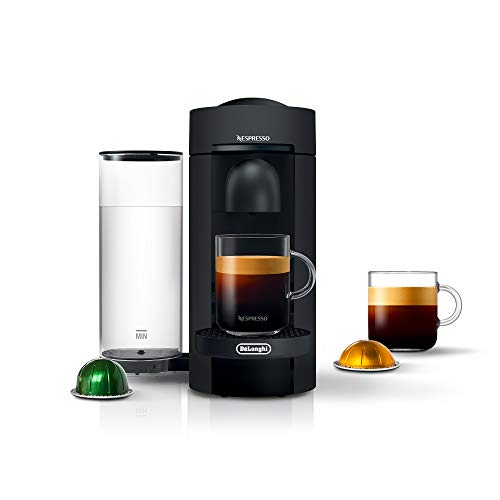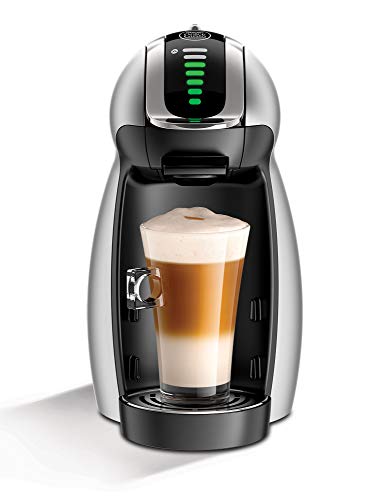In the market for a reliable and convenient coffee capsule-based espresso machine? If you’ve narrowed your search down to the Nespresso and Dolce Gusto machines, get ready.
Both machines have their pros and cons, but which one is right for you?
Ultimately, your choice will come down to personal taste, budget, and the features you’re looking for in a machine.
Read on for a comprehensive comparison of the two machines, and to learn a bit more about which one may be right for you and your lifestyle.

Nespresso and Dolce Gusto: A Quick Recap
Invented in 1976 by Swiss inventor Eric Favre, Nespresso machines were made with one goal in mind: to create convenient and high-quality espresso and to make it available to anyone, regardless of their experience behind a cafe counter.
Nestlé released the first Nespresso machine in 1986.
Today, Nespresso is one of the largest and most popular coffee machine companies in the world, with sales of over 14 billion coffee pods per year and machines available in 64 countries.
As for Nescafé, it’s been a household name in the coffee space for nearly a century. This brand of coffee, developed by the Nestlé company in 1930, was created in part to help preserve the surplus coffee supply in Brazil.
In 1938, not long after the project began, it was introduced to the world under the brand name “Nescafé” (a mashup of the names “Nestlé” and “café”).
Today, Nescafé has grown past its humble origins into a formidable coffee corporation of its own, complete with its own espresso machine lineup.
Nescafé introduced the Dolce Gusto coffee system in 2006 (fun fact: the name means “Sweet Taste” in Italian).
Nespresso vs. Dolce Gusto: What’s the Difference?
Since both machines fall under the Nestlé umbrella, is there really much difference between the two machines?
While there certainly are a few similarities in the way that the machines are built and how they function, there’s much more that sets these two machines apart.
Similarities
The biggest similarity between Nespresso and Dolce Gusto machines is that they both function on a single-serve capsule-based brewing system.
Both are excellent to have on hand for busy mornings or in office environments, or if you simply want to be able to brew espresso at home without learning how to pull a shot.
Both machines are also products of the same parent company, Nestlé. But just because the machines are both distributed by the same corporation, that doesn’t mean that they’re similar in build quality or design.
Differences
While both of these machines function similarly, that’s where the resemblance stops. Both machines differ in terms of size, build quality, materials, and design.
While the Dolce Gusto is more affordable, you can tell the difference in the build quality. Between the two machines, Nespresso comes out on top in terms of offering a more luxurious and high-end brewing experience.
It’s also important to note that these two coffee machines do not use the same coffee capsules, and they’re not interchangeable.
Since their designs are different, they can’t use the same shapes for their capsules.
Who Are Nespresso and Dolce Gusto Machines Suited For?
The coffee machine you choose will heavily depend on your lifestyle and what features are important to you.
Nespresso machines will only brew espresso and lungo, with little variety apart from the flavors of the pods.
The Dolce Gusto machines don’t quite match the Nespresso in terms of taste, but they are capable of brewing a much larger variety of beverages and sizes.
If you’re looking for a slightly more versatile machine at a lower price that makes a decent, mid-their cup of coffee, you won’t be disappointed with the Dolce Gusto.
However, if you’re willing to shell out more (both upfront and in the long term), then Nespresso will offer a better tasting pour and a more high-end experience overall.
Nespresso vs Dolce Gusto: A Side-By-Side Comparison
Nespresso Machines
Probably the biggest name in capsule-based coffee brewing machines, Nespresso has a long and storied history of providing quality coffee in a quick and convenient system.
Known for its easy-to-use brewing system and its stylish, luxurious branding, this is the machine for those who want all the indulgence of a cafe shot, without the fuss (or cost) of a full espresso machine.
What We Like:
- Even the more basic coffee machines in Nespresso’s lineup will produce a quality, great-tasting cup of coffee with a rich, delicious crema.
- Most machines include a built-in container for used capsules, so you don’t have to remove them each time the machine is used.
- The OriginalLine machines are compatible with third-party and reusable capsules, which can save you money in the long run.
- The water reservoirs are large and easy to remove, perfect for heavy coffee drinkers or those who share the machine with several others.
- Nespresso offers a wide range of coffee flavors for both lines of machines, and there’s even more variety if you use Original Line capsules.
- The Original Line machines use 19 bars of pressure to create beautifully rich espresso with a gorgeous crema.
What We Don’t:
- Nespresso machines don’t have the ability to brew tea, hot chocolate, or even dispense hot water. They’re almost exclusively espresso machines.
- Some machines do not include milk accessories like a steam wand or milk frother, so you’ll have to pay more to complete your setup.
- The Nespresso VertuoLine machines (and the pods) cost more than both the Nespresso Original line and the Dolce Gusto machines. They’re also not compatible with third-party or reusable pods.
- The VertuoLine machines use centrifugation to create pressure while brewing, but they don’t use bars of pressure to create authentic espresso.
The Bottom Line:
The Nespresso system is undoubtedly one of the most efficient ways to prepare coffee quickly and efficiently.
And while some coffee enthusiasts may turn their noses up at the “espresso-like” coffee made by the VertuoLine machines, most home coffee drinkers won’t taste much of a difference.
However, in the long term, owners of espresso machines should be prepared to pay more for convenience.
The costs of the pods tend to add up over time, and while they’re not as expensive as a daily trip to the cafe, they’re much more expensive than other home brewing methods.
Dolce Gusto Machines
Versatility is the name of the game when it comes to Dolce Gusto.
With a whole host of coffee sizes and beverage settings, users can prepare a variety of coffee drinks using the Dolce Gusto machines, including Espresso, Cappuccino, Latte Macchiato, Espresso Lungo, and more.
The Dolce Gusto machines can also be used to make hot chocolate and cold drinks. With all these options, budget-conscious coffee lovers are sure to get their money’s worth.
What We Like:
- The heat-up time is quick, perfect for those mornings when you’re in a rush.
- The design is intuitive and easy to use. It’s not difficult to insert the capsules or start the brewing process.
- The Dolce Gusto machines utilize 15 bars of pressure to create quality authentic espresso.
- Dolce Gusto coffee machines have a more affordable upfront cost compared to the Nespresso machines, which tend to be much more expensive.
- There are Dolce Gusto capsules available to brew tea and hot chocolate, not just espresso.
- The Dolce Gusto pods are a bit cheaper than the Nespresso by a few cents per pod. While that doesn’t seem like much on its own, over time the savings will add up.
What We Don’t:
- The water reservoir is small and will need to be refilled often if the machine is used multiple times a day.
- Most Dolce Gusto coffee makers don’t have a container for the used coffee capsules, unlike many Nespresso machines. The capsules will have to be manually removed each time the machine is used.
- The taste of the coffee the Dolce Gusto machines produce is a bit underwhelming; it’s not quite as intense or strong as the Nespresso, or even a drink you’d get at a coffee shop.
- The Dolce Gusto machines are not compatible with third-party capsules, so you’re stuck with the licensed Dolce Gusto capsule selection.
- The Dolce Gusto capsules are made of plastic and are not recyclable. They’re also larger than the Nespresso capsules.
The Bottom Line:
While not as flashy or stylish, Dolce Gusto machines are a reliable and quality alternative to Nespresso machines, especially for those who are looking for a budget machine that still offers the convenience of coffee capsules.
While they’re less well-known than their Nespresso counterparts, they offer a wide variety of drink capsules, a variety of beverage sizes, and cold brewing options, all at a more affordable price point.
Final Thoughts
Now that you’ve got a better idea of the differences between Nespresso and Dolce Gusto machines, you can make an informed choice about which machine is right for you.
Remember that it’s most important to consider how you’ll use the machine, what features you won’t compromise on, and what your budget is, before deciding.
If you’re willing to pay a bit more, Nespresso machines offer a better-quality cup of coffee and a higher-end design, but they’re more expensive from day one all the way through the life of your machine.
If you’re unsure about which Nespresso machine to choose, consider checking out the differences between the Original Line and the VertuoLine, or maybe check out which are the best Nespresso coffee pods.
If you’re looking for a cheaper and more versatile option that still gets the job done, then you may want to consider the Dolce Gusto machines instead.
Happy Caffeinating!









